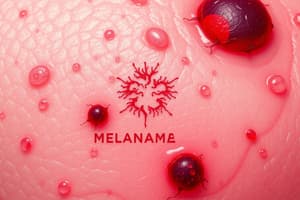Podcast
Questions and Answers
What is a primary characteristic of malignant melanoma?
What is a primary characteristic of malignant melanoma?
- Diameter greater than 6 mm (correct)
- Regularly shaped borders
- Consistently light brown color
- Uniform pigmentation
Dysplastic nevi are not considered precursors to melanoma.
Dysplastic nevi are not considered precursors to melanoma.
False (B)
What treatment options are available for malignant melanoma?
What treatment options are available for malignant melanoma?
Surgical excision, chemotherapy, immunotherapy, radiation therapy
Malignant melanoma often displays __________ borders.
Malignant melanoma often displays __________ borders.
Match the types of nevi with their descriptors:
Match the types of nevi with their descriptors:
What type of basal cell carcinoma appears as a flat papilloma or plaque, often erythematous, with well-defined borders?
What type of basal cell carcinoma appears as a flat papilloma or plaque, often erythematous, with well-defined borders?
Pigmented basal cell carcinoma typically appears as a dark lesion with shiny surface and well-defined borders.
Pigmented basal cell carcinoma typically appears as a dark lesion with shiny surface and well-defined borders.
Which type of carcinoma is known for causing hardening of the area surrounding the tumor?
Which type of carcinoma is known for causing hardening of the area surrounding the tumor?
The most common areas for squamous cell cancer development are the __________ and neck.
The most common areas for squamous cell cancer development are the __________ and neck.
Match the treatments to their descriptions:
Match the treatments to their descriptions:
Which carcinoma resembles a smooth pimple that grows steadily?
Which carcinoma resembles a smooth pimple that grows steadily?
Cryotherapy is a treatment option that involves heating the tumor to remove it.
Cryotherapy is a treatment option that involves heating the tumor to remove it.
Describe a common characteristic of tumors that ulcerate and bleed easily.
Describe a common characteristic of tumors that ulcerate and bleed easily.
What indicates that a lesion from actinic keratosis may be transforming into a malignancy?
What indicates that a lesion from actinic keratosis may be transforming into a malignancy?
Actinic keratosis lesions often present as rough, shiny macules with no bleeding when scales are removed.
Actinic keratosis lesions often present as rough, shiny macules with no bleeding when scales are removed.
Name two treatment options for actinic keratosis.
Name two treatment options for actinic keratosis.
Actinic keratosis predominantly occurs on the face, dorsa of the hands, and __________.
Actinic keratosis predominantly occurs on the face, dorsa of the hands, and __________.
Match the treatments for actinic keratosis with their descriptions:
Match the treatments for actinic keratosis with their descriptions:
What is the primary focus of treatment for nonmelanoma skin cancer?
What is the primary focus of treatment for nonmelanoma skin cancer?
The cure rate for nonmelanoma skin cancer treatments is less than 50%.
The cure rate for nonmelanoma skin cancer treatments is less than 50%.
List two treatment modalities for malignant melanoma.
List two treatment modalities for malignant melanoma.
After the malignant tissue is removed, patients should undergo regular examinations for __________.
After the malignant tissue is removed, patients should undergo regular examinations for __________.
Match the following treatments to their primary method of action:
Match the following treatments to their primary method of action:
Flashcards are hidden until you start studying
Study Notes
Congenital Nevi
- A precursor to melanoma
- Can range in size from small to covering the entire body
Dysplastic Nevi
- A precursor to melanoma
- Often slightly raised, with an irregular surface and fairly regular border
Lentigo Maligna
- A precursor to melanoma
- Tan or black patch on the skin that looks like a freckle
- Grows slowly, becoming mottled, dark, thick, and nodular
- Usually seen on one side of the face in an older adult who has had a large amount of sun exposure
Malignant Melanoma
- Ranges in color from brown to black
- Have irregular pigmentation with mixtures of tan, brown, black, red, and pink
- May have an area of lighter pigmentation surrounded by an area of deeper pigmentation
- Irregular borders
- Often appear on the face, trunk, and arms but can be seen on the scalp, female breast, groin, and buttocks
- Asymmetrical, with an irregular border
- Color variegation
- Diameter greater than 6 mm (the size of a pencil eraser)
- Surgical excision is used to remove the melanoma
- Chemotherapy, immunotherapy and radiation therapy may be used to treat melanoma
Treatments for Melanoma
- Surgical excision
- Chemotherapy
- Immunotherapy
- Radiation therapy
- Regular examinations to assess for recurrence
Basal Cell Carcinoma
-
Nodular basal cell carcinoma:
- Resembles a smooth pimple
- Grows steadily
- May ulcerate and bleed easily
- Most common on the head, face, and neck
-
Superficial basal cell carcinoma:
- Flat papule or plaque
- Defined borders
- Often erythematous
- May ulcerate and have crusts or erosions
- Most common on the trunk and extremities
-
Pigmented basal cell carcinoma:
- Dark brown, blue, or black
- Shiny surface
- Well-defined borders
-
Morpheaform basal cell carcinoma:
- Resembles a flat scar
- Forms finger-like projections
- Usually develops on the head and neck
-
Keratotic basal cell carcinoma:
- Similar to nodular basal cell carcinoma
- Begins as a firm, red nodule
- May be crusted with keratin
- Causes surrounding tissue to harden
- Most common on sun-exposed areas (forehead, nose, ears, lips, hands)
Squamous Cell Cancer
- Tumors:
- Ulcerate, bleed, and become painful as they grow
- May have a shiny, pearly white, or pink appearance
Treatment Options
- Surgery:
- Surgical excision
- Curettage and electrodesiccation
- Other treatments:
- Cryotherapy
- Radiotherapy
- Chemotherapy
- Immunotherapy
- Radiation therapy
- Biological therapy
- Vaccines
- Follow-up:
- Regular examinations to assess for recurrence
Actinic Keratosis
- Actinic keratosis is a precancerous skin condition characterized by rough, red patches that are typically a few millimeters in diameter.
- Lesions may be shiny or scaly; removing scales can cause bleeding.
- Multiple patches typically occur on the face, back of hands, forearms, and sometimes the upper trunk.
- Enlargement or ulceration of lesions suggests a potential transformation to malignancy.
- Treatment options include cryosurgery, topical creams or gels, shave excision, curettage and electrodesiccation, photodynamic therapy, chemical peels, laser surgery, and monitoring for changes or abnormalities in lesions.
Skin Cancer Treatment Team
- A collaborative team of healthcare professionals (HCPs) is crucial for patient care, promoting early detection, prompt intervention, and better outcomes.
Non-Melanoma Skin Cancer Treatment
- Treatment focuses on removing all malignant tissue.
- Methods include surgery, curettage and electrodessication, cryotherapy, or radiotherapy.
- These methods have a cure rate exceeding 90%.
- Other treatment options include chemotherapy, immunotherapy, and radiation therapy.
- Biological therapies with interleukin-2 and interferon, and therapeutic vaccines containing melanoma antigens are sometimes used.
Non-Melanoma Skin Cancer Post-Treatment
- Regular examinations are needed to detect recurrence.
Malignant Melanoma Management
- Starts with identification, diagnosis, and tumor staging.
- If treatable, tumors are removed through surgical excision.
- Other treatment options include chemotherapy, immunotherapy, and radiation therapy.
Studying That Suits You
Use AI to generate personalized quizzes and flashcards to suit your learning preferences.




